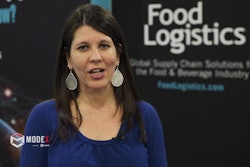
Quicker. Faster. Better. Today’s 21st century technology developments are geared up to deliver industry-wide advances more transformative than the last.
But, what assurances are there that these all-new advances will work in the real world? Where do the key opportunities exist within food and beverage manufacturing, and where do the potential bumps in the road lie?
From augmentation and 3D printing to 5G and robotics-as-a-service, new technologies are shaping sectors, including food manufacturing, by the day, as companies come under increasing pressure to meet consumer demand, safety and industry guidelines and work with greater efficiency.
Among this flourishing of new technologies and the rise of Industry 4.0 is the impact of predictive simulation. That’s why digital twins have a profound advancement in how companies manage risk and growth.
New processes = new risks
With more and more manufacturers under pressure to innovate and meet efficiency and performance targets, new processes inevitably involve multiple unknowns that can be difficult to predict and costly and time consuming to make right the first time.
Historically, static modelling has helped in certain areas, but with the increased demand on companies to innovate, predictive digital twins offer more dynamic and intelligent ways of modelling all stages of the manufacturing process and creating business value and unprecedented insight.
Putting those ‘what ifs?’ to the virtual test
Digital twins enable food and beverage manufacturers to model their production processes within a virtual environment whereby you can test, experiment and trial new solutions or ways of working.
They work by replicating real life scenarios, such as existing machines or plant lines, which can then be continuously tested, highlighting opportunities for improvement. They’re so advanced that it’s possible to test configurations on virtual production lines before physical lines have even been built.
Being able to ask all of the “what if?” questions allows companies to understand the future impact and consequence of each scenario, without incurring any risks in terms of costs or brand reputation. This foresight can prove invaluable to all business planning cycles.
Real life food for thought
When Mars wanted to drive efficiencies across its business without compromising the quality of products within its local markets, it viewed digital twins as the logical technology to turn to.
At the time, the company had almost three dozen product lines running across six sites in the United States. Each site involved complex internal supply chain pressures generated by varied chocolate-making capabilities, multiple chocolate types and varying product mix and consumer demands.
Initial work revealed that the scale, complexities and interdependencies involved would require modelling capabilities more sophisticated than the company’s existing spreadsheet-based capacity planning systems.
A simulation model was created that predicted Mars’ supply chain performance based on the above variables. This provided Mars with insight into its existing and planned future operations. This insight then enabled it to identify current risks throughout the supply chain and highlight opportunities for cost savings and performance improvements.
In turn, this meant Mars had the necessary foresight to develop business cases for new facilities and justify investments in its chocolate-making capacities, which enabled the company to make the right decisions at the right time.
The future appetite for digital twins
The world of food manufacturing is rapidly evolving to adapt to the challenges and opportunities that Industry 4.0 presents. Technological developments are inevitable, but so too are risks, unforeseen challenges and multiple “what ifs?”
A growing number of food manufacturers see the potential in digital twins to enable them to plan their futures with clarity and make the right decisions quickly with minimum hassle or impact to their production outputs and supply chains.
Fundamentally, digital twins provide organizations with answers to all of those “what ifs?”, allowing them to make production decisions that directly benefit their business. This leads to smarter risk-free business decisions and drives higher returns on investments, as discovered by Mars.

















![Top Tech Startup Logo 2025 Vertical [color] (1)](https://img.foodlogistics.com/mindful/acbm/workspaces/default/uploads/2025/07/top-tech-startup-logo-2025-vertical-color-1.pZkBK95TLe.png?ar=16%3A9&auto=format%2Ccompress&bg=fff&fill-color=fff&fit=fill&h=135&q=70&w=240)

